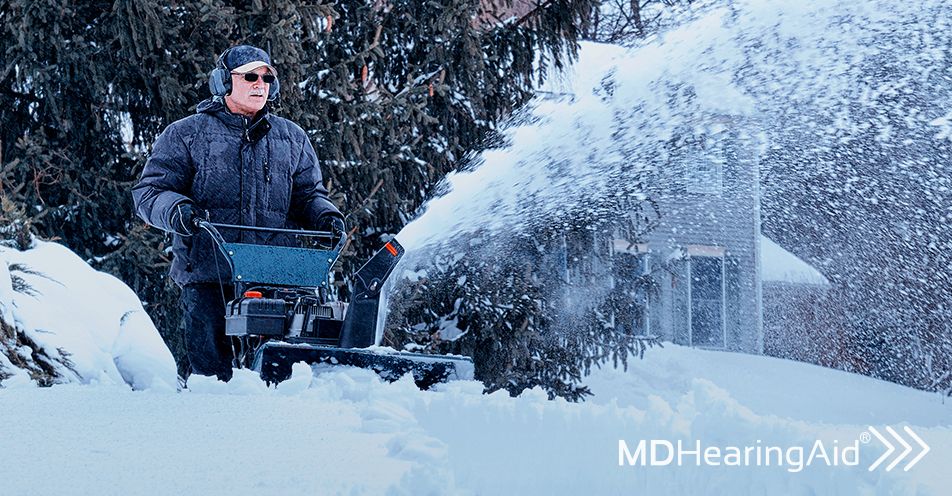By now, most of the country is deep into winter. In some parts of the United States, that means sub-zero temperatures; in other areas, rain and high winds. Here are some important tips for protecting your hearing and maintaining your hearing aids this time of year.
Protect your hearing from winter machines
From snowmobiles to snow blowers, common winter noises produce potentially damaging decibel levels. Noise-induced hearing loss (NIHL) affects about 15% of the U.S. population. Even if you already have some degree of hearing loss, you can further harm your hearing if you don’t take precautions.
For example, the average conversation occurs at about 60 decibels, a washing machine generates approximately 70 decibels worth of noise, whereas a snow blower puts out about 85 decibels. With increased decibel levels, it’s not just the sound levels that can be harmful, but the length of exposure. Some noises, like thunder, fireworks, jet engines, gunshots or concerts, can cause damage in just one minute.
It is recommended that you remove your hearing aids in high decibel scenarios and wear hearing protection instead. For instance, while enjoying a winter weekend of snowmobiling, an ear plug specially designed to reduce noise can help protect your hearing from permanent damage, even inside the confines of your helmet. Ear plugs come in a variety of styles and sizes and typically lower noise levels by 15 to 30 decibels. Look for them at your local drug store, sporting goods store, or hardware store.
Protect your hearing aids from winter conditions
If you get hot and sweaty shoveling your driveway or brushing snow off your car, know that perspiration can cause damage to both your hearing aids and batteries. Extreme temperature changes, like leaving your hearing aids in the glove box or cup holder of your car can also lead to condensation, a known cause of electronic corrosion and failure.
Regardless of how you spend your time outdoors this winter, be sure to safely store your hearing aids in their case or a hearing aid dehumidifier. Searching for a missing hearing aid in a snow drift is akin to looking for a needle in a haystack!
Dress for success
Winter has a dress code all its own, especially for hearing aid wearers. Protect your ears and hearing aids from cold air by wearing earmuffs, hats, or wrapping a scarf around your head in extreme cold. These measures should help protect sensitive ear tissue from shrinking in the cold, potentially causing your hearing aid to feel uncomfortable or even fall out. Be sure to check the placement and positioning of your hearing aids after removing your hat, scarf, or earmuffs, as they can dislodge your hearing aids.
In addition, earmuffs, which cover the entire ear and form a seal to help block potentially damaging noise, can offer as much as 15 to 30 decibel level in noise protection. If you experience feedback or whistling while wearing earmuffs or a hat with your hearing aids, temporarily turn the volume down. Don’t forget to return them to their normal volume level after you remove your coat and hat.
The importance of regular hearing aid cleaning and care
Regular cleanings, as described in your hearing aid user manual, can help keep your hearing aid in tip-top shape. Tubes and tips should be cleaned weekly and replaced every few months, or more often as needed, depending on the amount of wax and other debris your ears produce, and your exposure to moisture and extreme temperature changes.
Should your hearing aid stop working properly this winter, here are a few troubleshooting tips:
- Make sure your hearing aids’ off/on/power switch is in the correct position. It may have accidentally been turned off removing your hat, scarf, earmuffs, or the hood of your winter coat.
- Double check to make sure the batteries have been inserted correctly. You should also check to make sure the battery is not corroded. If there is a white powdery substance on the battery or the interior of the battery compartment, you have a bad battery. Dispose of the battery properly and replace it with a fresh one.
- Inspect the tubing to see if it has become clogged with debris, ear wax, or moisture. You’ll be able to tell if there is a moisture buildup by the condensation in the tube.
- In the event your hearing aid is exposed to moisture, wipe it down to remove all visible moisture and place it in a hearing aid dehumidifier or UV-Clean & Dry Box immediately.
Take good care of your hearing aid investment this winter and they’ll take good care of you. You can find answers to other frequently asked questions here. Don’t see the answer to your winter hearing aid question? Our skilled customer service staff is only a phone call or email away.
